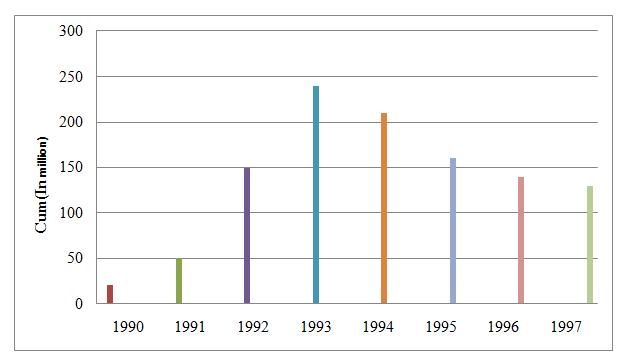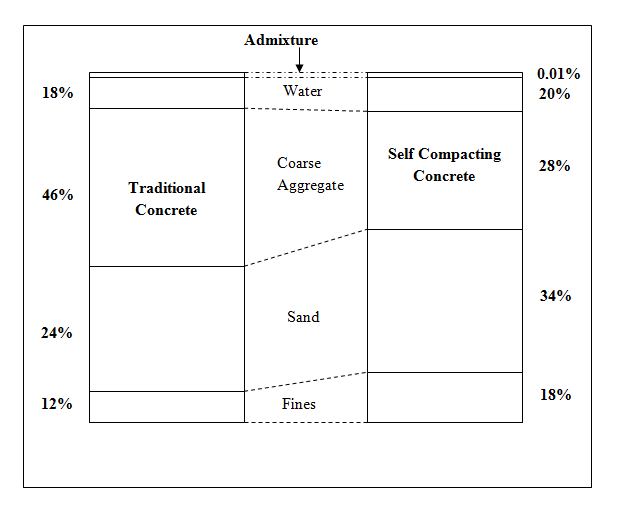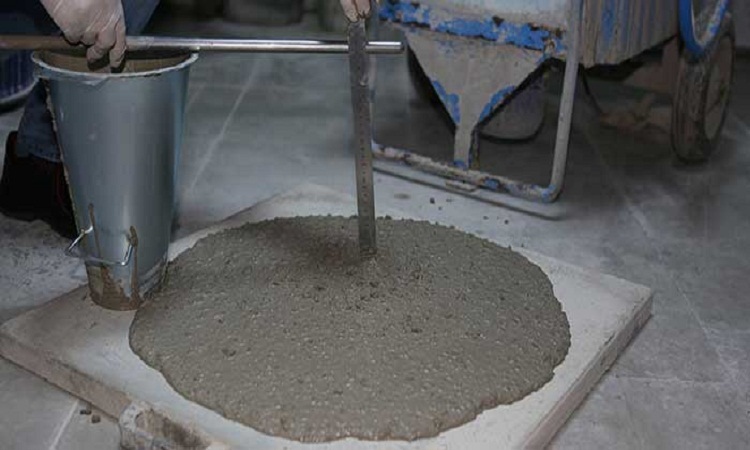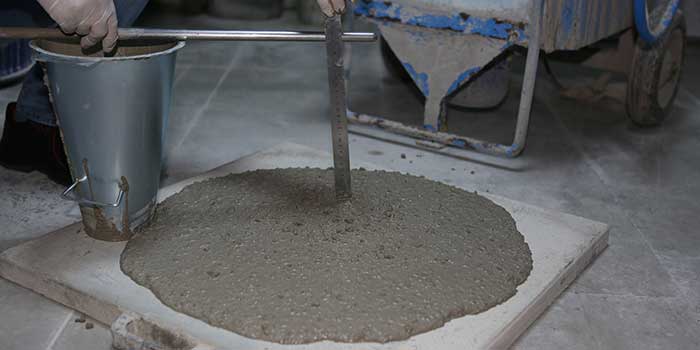Self-Compacting Concrete was first invented in Japan around the year 1980. Professor H. Okamura from the University of Tokyo, Japan is mainly responsible for initiating the evolution of such types of concrete. The need for the development of such concrete arose from the scarcity of skilled manpower in Japan during this period.
Self-Compacting Concrete was invented to overcome the deficiency of skilled manpower & problems of placing and compacting congested civil engineering structures. Thereafter, it has been observed that Self-Compacting Concrete not only reduces the requirement of manpower, both unskilled and skilled but also results in more durable concrete.
Self-compacting concrete (SCC) can be considered as the greatest technical development in concrete technology over the years, at least from 1980 till today. This is the concrete of the future as it will be replacing the normal concrete because of its many advantages. It is reported that in the year 2003 approximately 50% of the total concrete executed in Japan was SCC. The growth of SCC in Japan is depicted in the figure. Subsequently, Self-Compacting Concrete (SCC) was used in many developed and developing countries such as Canada, Sweden, Netherlands, Taiwan, Thailand, USA, Austria, Korea, France, U.K, Germany, etc.

In India, Self-Compacting Concrete (SCC) was used for the first time by Gammon India Ltd in the year 2003.
Self-Compacting Concrete is also known as Self-Consolidating Concrete or Silent Concrete though widely it is referred to as Self-Compacting Concrete.
What is Self-Compacting Concrete?
“Self-Compacting Concrete is a highly workable and flowable concrete that flows and consolidates under its own weight without any segregation and maintaining its homogeneity, also flows through all shapes and obstructions and needing no vibrations for compaction.”
Thus the main requirements of Self-Compacting Concrete (SCC) are flowability, filling ability, self-compacting without segregation i.e. maintaining homogeneity.
The above all requirements can be achieved by proper mix design, which can be more appropriately stated as proportioning of various components of the concrete.
To achieve a highly flowable concrete, the low yield stress is required and for high resistance to segregation, a highly viscous material is needed. The addition of water in concrete decreases the yield stress but lowers the viscosity. The addition of a superplasticizer also lowers the yield stress but will decrease the viscosity slightly. On the other hand, the viscosity of a mix can be improved by changes in mix constituents or by adding a viscosity modifier but this will increase the yield stress of the paste. Thus a balance between the two essentiality needs to be implemented.
Mix Proportioning (Mix Design) of Self-Compacting Concrete (SCC)
In general, SCC has got less coarse aggregates, more fine aggregates as noted in figures below, and needs superplasticizer and viscosity modifying agent (VMA) as admixtures.


Some broad guidelines for proportioning of various components of Self-Compacting Concrete (SCC) are given below
Coarse Aggregate
Generally, the size of coarse aggregate is limited to 20mm, sometimes to 15mm though Self-Compacting Concrete (SCC) has been used even with 40mm aggregate where there is no congestion of steel reinforcement.
In coarse aggregates, aggregates greater than 4.75mm are considered as coarse aggregate.
Regarding the characteristics of different types of coarse aggregates, crushed aggregates tend to improve the strength because of the interlocking angular particles, but at the same time reduce the flowability, while rounded aggregates improve the flow due to the lower internal friction & lesser surface area per mass.
Gap graded aggregates are generally better than continuously (well) graded aggregates as well as graded aggregates experience greater internal friction and give reduced flowability.
The amount of coarse aggregates is generally less than 50% by weight of total aggregates (Coarse and fine aggregate combined). The normal range of coarse aggregates is generally 700 kg/m3 to 800 kg/m3 of concrete. By volume, coarse aggregate content is 50% to 60% of the total aggregate volume. The actual volume of the coarse aggregate depends upon the characteristics of the coarse aggregate and the maximum size of the coarse aggregate. The lower the maximum size aggregate, the higher is the proportion of coarse aggregate and vice-versa.
Fine aggregate (sand)
Aggregates smaller than 4.75mm and up to 0.075mm are considered as fine aggregates (sand). Sand in Self Compacting Concrete is generally finer than in normal concrete. The ratio of the weight of sand to that of coarse aggregates could be in the range of 1.1 to 1.6. The ratio is on the lower side of this range if filler dust is used in Self-Compacting Concrete (SCC).
The volume of sand content should be in the range of 40% to 50% of the mortar/paste volume. Both natural sand and crushed sand particle size range can be used.
Fines
Particles that are smaller than 0.075mm are considered as dust/fines. The amount of dust to be used depends on various factors including whether secondary cementing materials like ground granulated blast furnace slag (GGBS), fly ash, and silica fume is used or not. If such secondary cementing materials are used, the necessity of fines reduces. However, the requirement for fine aggregate is completely eliminated by using secondary cementing materials. An increased fine helps in preventing segregation.
In the absence of secondary cementing material, the amount of fine is generally 160 liters to 240 liters or 400 kg/m3 to 600 kg/m3 of concrete.
Cement
The content of cement generally used in Self-Compacting Concrete (SCC) is the same as normal concrete. The correct choice of cement type is generally dictated by the specific requirement of each application or what is currently being used by the producer rather than the specific requirement of Self-Compacting Concrete (SCC). The addition of secondary cementing material (SCM) like fly ash, granulated blast furnace slag (GGBS), silica fume is beneficial.
Water
From the durability consideration, the water-cement ratio (w/c ratio) should be restricted as in normal concrete and it should preferably be less than 0.4. Generally, free water should be less than 200 liters/m3 of concrete. The ratio of Water/powder by volume is generally 0.80 to 1.10.
Chemical Admixtures
Advances in admixture technology have played a major role in the development of Self-Compacting Concrete (SCC). Modern superplasticizer based on polycarboxylic ethers (PCE) promotes good workability and can be added at any stage of the batching cycle. They acquire this with a mechanism of electrostatic repulsion in combination with steric hindrance.
Viscosity modifiers admixtures enhance resistance to segregation while still maintaining high fluidity, allowing concrete to flow through narrow spaces.
Typical Mix Proportioning of Self-Compacting Concrete (SCC) used in the 1970s and 1980s
| Ingredient/Property | Mix Details |
| Ordinary Portland Cement | 400 Kg/m3 |
| Very Fine Sand (0.075mm-0.6mm) | 180 Kg/m3 |
| Sand (0mm-5mm) (Fine Aggregate) | 990 Kg/m3 |
| Gravel (5mm-15mm) (Coarse Aggregate) | 630 Kg/m3 |
| Water | 190 Kg/m3 |
| Super Plasticizer | 7 Kg/m3 |
| Water/Cement Ratio | 0.47 |
| Slump | 260 mm |
Considerable modifications to improve Self-Compacting Concrete (SCC) have taken place subsequently. The below table provides the mix proportions and properties of fresh concrete for Normal Concrete (NC), High-Performance Concrete (HPC), and Self-Compacting Concrete (SCC). This table is a good indication of the variation of composition particularly with respect to coarse and fine aggregates, slumps, etc.
Mix Proportions and Properties of Fresh Concrete for Normal Concrete (NC), High-Performance Concrete (HPC) and Self-Compacting Concrete (SCC)
| Material | NC | HPC | SCC |
| Ordinary Portland Cement | 340 kg/m3 | 300 kg/m3 | 220 kg/ m3 |
| Slag | – | 60 kg/ m3 | 80 kg/ m3 |
| Fly Ash | – | – | 120 kg/ m3 |
| Free Water | 193 kg/ m3 | 192 kg/ m3 | 182 kg/ m3 |
| Sand | 864 kg/ m3 | 835 kg/ m3 | 1030 kg/ m3 |
| Gravel | 939 kg/ m3 | 945 kg/ m3 | 724 kg/ m3 |
| High-range water-reducing Admixture/Water Reducer | 1.32 kg/ m3 | 3.46 kg/ m3 | 5.04 kg/ m3 |
| Water/Cementitious Material Ratio | 0.556 | 0.533 | 0.433 |
| Sand/Aggregate ratio | 0.47 | 0.48 | 0.59 |
| Ratio of F.A./C.A. | 0.92 | 0.88 | 1.42 |
| Slump, mm | 75 | 220 | 265 |
| Slump flow, mm | – | – | 540* |
| V-Funnel test, sec | – | – | 2.97* |
| Air Content % | 1.5 | 1.1 | 5 (High) |
| Unit Weights, kg/m3 | 2338 | 2332 | 2354 |
*Lower than presently prescribed
NC- Normal Concrete
HPC- High-Performance Concrete
SCC- Self-Compacting Concrete


